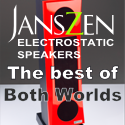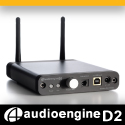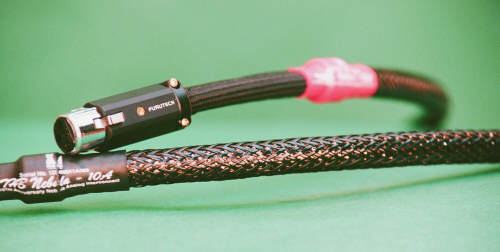|
|
You are reading the older HTML site
Positive Feedback ISSUE 64
dynamic design Anniversary Edition Nebula Cables as reviewed by Marshall Nack
One day I received an email from my editor inquiring if I'd be interested in reviewing the new top-of-the-line Nebula series cables from Dynamic Design Corp. While I'd heard of this boutique cable company now and then, they weren't really on my radar. A quick look around the web turned up nothing but sky-high praises for their new line. Most significantly, my associate Bob Levy called the Nebula power cords "the best-of-the-best" in his review. Let's get things moving, I replied without ado. Burn-In and Installation When several sets of Nebula demonstration cables arrived soon after, they sounded dark and warm. Then surprisingly, after 70 or so hours they opened up and became one of the most neutral wires. Now understand these are demo wires that are "on the road" all the time. An email from the designer clarified: For some unknown reason, these cables don't like to travel and need full burn-in after commuting. That's odd, I thought. On the other hand, if you put them aside for a week, just a couple of hours brings them up to speed.
Overview The Nebula are indeed very good. Tonal balance is a bit dark and body is remarkably full for the power cords and speaker cable (but not so for the interconnect wires). This is great if you can use more weight (who couldn't); otherwise, you'll need to lighten up the palette somewhere after installing them. The Nebula are quiet, about as quiet as I've heard, no doubt due to several innovative shielding techniques we'll get to in a bit. Frequency response is extended and notably smooth. They render low-level events quieter than other cables, resulting in an extremely wide dynamic range. I found I had to increase the volume when doing A/B comparisons. Transient Behavior The play of instruments on the Nebula soundstage displays an unusual mix of qualities. Other cables, even the best ones with natural, un-hyped transient behavior, do something that announces the arrival of an event and lets you know a split second before it actually occurs. The Nebula avoids this. That is, events appear and disappear with no fanfare. The way it happens is unremarkable in the best sense and reminds me of how passive pre-amps do it—in a very svelte manner with absolutely no etching. I am indebted to the keen observation of my panelist Sheldon for the following two insights. First, he noted the Nebula are smooth and totally grainless in their treatment of the middle part of the note, like tubes, but the way they start and stop is like solid-state. This translates into fast rise times and a bit of warmth in the middle. His second, related insight had to do with the clustering of attributes—how cables can be either clean and warm or clean and cool. Most often cables that are clean are also cool; the Nebula are the rare bird that is extremely clean but also slightly warm. Micro Dynamic Vitality There were two areas where the Nebula left me scratching my head and I had to invent phrases to describe what I was hearing. The first was micro dynamic vitality. Think of your typical listening session. Most systems command your full attention when they are playing loud, dynamic passages. When that passes, they lose you. You go back to your book or other amusement—until the next loud, dynamic passage comes along. And so it goes. Soft passages lack immediacy and recede to the background. (And this is when the system sounds good!) BTW, this is not related to resolution. I've met plenty of high res cables, even a few with higher res than the Nebula, that still don't maintain life and vitality in low-level signals. Low-level passages need to sound as direct and immediate as those with high SPLs. Cables (and components) can also be guilty of this in selective frequency bands, for example, becoming less responsive to low frequencies. They can also place selective frequencies forward or back in the soundstage.
Whether it's the low strings or a soft flute/oboe duet, whatever frequency range is playing, whatever the volume, these passages come alive with the Nebula. They do not play favorites. Dynamic Independence Building on this vitality, the Nebula grant each instrument dynamic independence. The rhythmic line of the instrument with the short sixteenth notes is left intact, unaffected by the one playing half or quarter notes on its left. Contrapuntal passages thrive on this and gain momentum and the stage becomes lively with divergent activity occurring all over. Soundstage I've never heard the physical stage recreated as well. From the first chairs on back, the Nebula resolve row after row in receding layers. Images are isolated to a degree unusual even for top-tier cables. This leaves image placement exceptionally precise and exposed. However, these same qualities result in less continuity across the stage or, alternately, what some call a holistic quality.
A good example of this is Sibelius: Kullervo (Ondine ODE 1122-5, SACD), which is scored for full orchestra and large male chorus. (I inadvertently acquired a second recording with the LSO and Colin Davis—the Ondine SACD is the one to get for superb sound and performance.) I had a newfound appreciation for the effort and skill involved in pulling off the performance, both on Sibelius' part for conceiving it and also for the conductors' contribution in realizing it. This is one heck of a busy score and the Nebula let you know everything going on and leave nothing uncertain. "You can hear all the parts," was the often unsolicited comment from my panel. Moving off the stage, the Nebula give you less information about the side and rear walls and the atmosphere of the hall. Everything is happening up front. This meant some listeners found them dry, and, yes, in comparison to many cables they are. It's funny. I can remember when this "resolving the hall" was fairly rare. (And that wasn't so long ago). Back then, it was notable when it happened: Nowadays, it's notable when it doesn't happen. Obviously, this is not your usual soundstage recreation. Which way is right? The answer is both are. When I sit in the front rows at either Alice Tully or Zankel (one of the smaller venues in the Carnegie Hall building), it sounds like the Nebula. When I'm mid-orchestra in Carnegie's main hall, the ambience and hall cues emerge. Bringing it back home to audio, it becomes a matter of personal preference. There is no doubt in my mind that Dynamic Design's chief designer, Olufemi A. Sonuga, wants it this way. His close attention to shielding and conductor geometry and his published design priority to eliminate noise while maintaining a full-bandwidth response are largely responsible for this voicing. (For more on this see the discussion below on Dynamic Shielding.) The main point is that a cable should not be messing with ambience, neither adding nor subtracting. You should hear a variety of hall ambience depending on the source. My sense is the Nebula is more honest than most.
The Neutrality Question OK, the Nebula grants images extreme independence; you will clearly "see" instruments. Typically, there's a price to be paid: most often it comes from compromised frequency integration and timbre. Does the Nebula sound lean and analytical? Frequency integration is not a problem. I've already mentioned how full bodied the images are and that the cables veer towards a bit of warmth, qualities that mitigate any tendency towards analytical. Plus decay trails are well represented. (This applies to the power cords and speaker wire, the interconnects less so.) Timbral Resolution/Accuracy Now, in regards to timbre, the discussion gets interesting. The instruments of the orchestra display wide ranging timbral variation—that's the beauty of the sound. For many of us, this is the most important gradient. Cables give you more, or less, of this. The difficulty is two-fold: It could be the cable isn't capable of reproducing subtle differences, in which case it's subtractive. Let's skip those; we're talking about the best of the high-end here. On the other hand, the cable may impose its own characteristics, an additive artifact. For instance, always adding ambience. In particular, a cable with a lush footprint may sound wonderfully acoustic, but will impart a sonic signature that makes everything sound beautiful. A variation on this is some cables give every event a full range of harmonics from low bass through high treble. But it often isn't like that. A clarinet playing in its middle register doesn't unleash a lot of high treble, or low bass, overtones. An upright bass doesn't display many, if any, treble overtones. With the best of the neutral cables you hear less footprint and more signal. These cables make it easy to assign a positive identification to a sound. Timbral accuracy refers to how close the cable's portrayal comes to "fool ya" realism. On this score, the Nebula get top grades. They have a vanishingly small footprint which means you get dramatically more signal. The second, related point is the Nebula are not lush, but neither are they skimpy—their portraits are just dense enough to be complete. Once again, my sense is the Nebula brings an unusual degree of honesty to their presentation. I hear very wide variation in their portraits and they make it easy to assign positive ID. A good example of this timbral accuracy is Fuller Nelson (Sunnyside SSC 1134), with Steve Nelson on vibes and Kirk Lightsey on piano. This is not a reference quality CD, but it will serve our purposes.
Except for those instances when Steve lets the notes sustain with their characteristic tremolo, it is not easy to discriminate if it's the piano or the vibes playing. With the Nebula, this becomes a piece of cake. Image Independence So, back to the question: When you sum these qualities, which often result in an analytical voicing, is that the case with the Nebula? The answer is it could be. The Nebula's effects are cumulative. I got terrific results with three power cords and one balanced interconnect on my digital front-end. Later, I swapped in the speaker cable, also with great results. However, when I substituted single-ended interconnect for the balanced IC, I began to hear things I didn't like. While there is always a difference between a company's balanced and single-ended wires, it was more noticeable with the Nebula. The single-ended IC is slightly drier and less liquid than the balanced one. For this reason, I'm giving the product line a mixed rating: the power cords are really world-class, competitive with the best I've tried, followed by the speaker cable; the balanced interconnect is slightly lower; the single-ended interconnect below that.
THB Nebula speaker wire Dynamic Shielding The Nebula incorporates some advanced, trade-marked engineering. Some of the highlights are:
THB Spkr with diodes When you power up the system, turn on the battery packs and little diodes light up on the speaker wire and the power cords. The effects of the active shields are audible after 1 minute, although full charging comes in about 10 minutes. At the end of the session, turn off the battery packs. The GIT uses two AA batteries. The designer does recommend you leave the battery on all the time to keep the shield charged. If left on they will last about 2 weeks. In his opinion all cables should have an active shield. The current Nebula IC is the exception—adding a shield would bulk it up too much, so they left it out. Eventually the Nebula will have a self-charging battery unit that stays on all the time. You can listen with the battery pack off, but I don't see why you would want to do that. With battery off, the treble is a little wild and the bottom not as potent. Turn the battery on and the sound becomes sweeter.
THB Nebula PC with battery pack Metallurgy Like many manufacturers, Dynamic Design is reluctant to discuss conductor metal. The Nebula use a combination of metals for maximum conductivity and linear frequency response. MSC™ (Multi-Solid-Core) conductors using solid-core conductors are chosen over stranded conductors because (according to Dynamic Design) the latter tend to have soft, diffuse edges. Implementing solid-core has entailed sacrificing some mechanical performance. Solid-core wires have a natural curve as it comes off the spool: they don't take well to changes in direction. Careful when you make a sharp bend—you may induce minor cracks or fissures. Ultra-thin wall, low-storage insulating dielectric materials are concentrically arrayed around the conductors. Implementing this has also entailed sacrificing some mechanical performance. Caveat Emptor A couple of caveats are warranted. These choices of shielding, dielectrics, and conductor geometry/configuration results in a fairly thin cable, but one with a very stiff shaft. They don't take well to sharp turns around corners. Exercise caution when bending the Nebula into position—don't force it. They also don't like to be twisted. DD knows this: it's not much of a problem with single-ended ICs, but when you order a balanced cable, they will orient the end-plugs suitably to conform to your components pins. (Believe it or not, I was told the current Nebula is not as stiff as earlier generations of DD cable designs.)
Thb Interconnect Conclusion Dynamic Design has been making cables for 12 years, but has remained a bit under the radar. With the new Anniversary Edition Nebula wire, this manufacturer becomes a force to reckon with in that corner of the audio world. Without a doubt, this product line is worthy of inclusion in the very select group in the Reference Class. The Nebula presentation is unlike that of the other members of this class that I'm familiar with. Its soundstage is extremely well-articulated and exposed. From the front row of players to the rear of the stage, your view is unimpeded. Instruments have great dynamic independence, which greatly benefits rhythms and counter-rhythms. Moving away from the stage, however, the rear and side walls and the atmosphere of the hall are not as defined. Top on the list of Dynamic Design's goals is neutrality, and in this the Nebula achieves spectacular success. The cable adamantly refuses to add color and has a vanishingly small footprint. At the same time, they let pass just enough timbral details to make a complete portrait—and no more. What you hear is less cable and more signal. The upshot is that from instrument to instrument there is more variability; from disc to disc there are more differences. There is a lot of truth in the Nebula's presentation. The power cords are the best of the product line, followed by the speaker cable—these are really world-class. The balanced interconnect is a small step down; the single-ended interconnect is a notch below that. Marshall Nack
Anniversary Edition Nebula VLT Digital Power
Cord
Anniversary Edition Nebula THB Analog Power
Cord
Anniversary Edition Nebula THB XLR IC
Anniversary Edition Nebula THB RCA IC
Anniversary Edition Nebula THB Speaker Cable
Dynamic Design Corp
|











